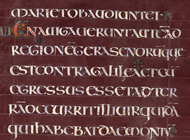|
While the earliest written Christian scriptures were simple, unadorned manuals, by the fifth and sixth centuries opulent materials, such as purple-stained pages and gold and silver inks, were used to confer prestige, and didactic picture cycles appeared on the walls of churches and in books.
Unease concerning idolatry in Jewish, Islamic, and Christian circles led to the destruction of images in the movement known as iconoclasm, which beset the Eastern Church in Byzantium during the eighth and early ninth centuries. Western Church authorities, however, understood that illustrations could convey the meaning of scripture; around 600, Pope Gregory the Great advised that in images the illiterate read.
Meanwhile, due in part to enduring Christian tradition, people continued to use distinctive and lavish forms of decoration to celebrate the Word of God. The sacred book became an iconic object, carried ceremonially in procession, read from during the liturgy, and displayed on the high altar.
By the year 1000, illuminated books symbolized the ongoing transmission of the Word. Books helped people believe that the Christian Bible had been handed down as a powerful unified whole. The transition from late Antiquity to the Middle Ages, and with it the process of formation of the Christian Bible, was complete.

|
 |
Click on an image for details:

The Stockholm Codex Aureus

The Stockholm Codex Aureus

Sion Treasure Book Cover

The Rabbula Gospels
|